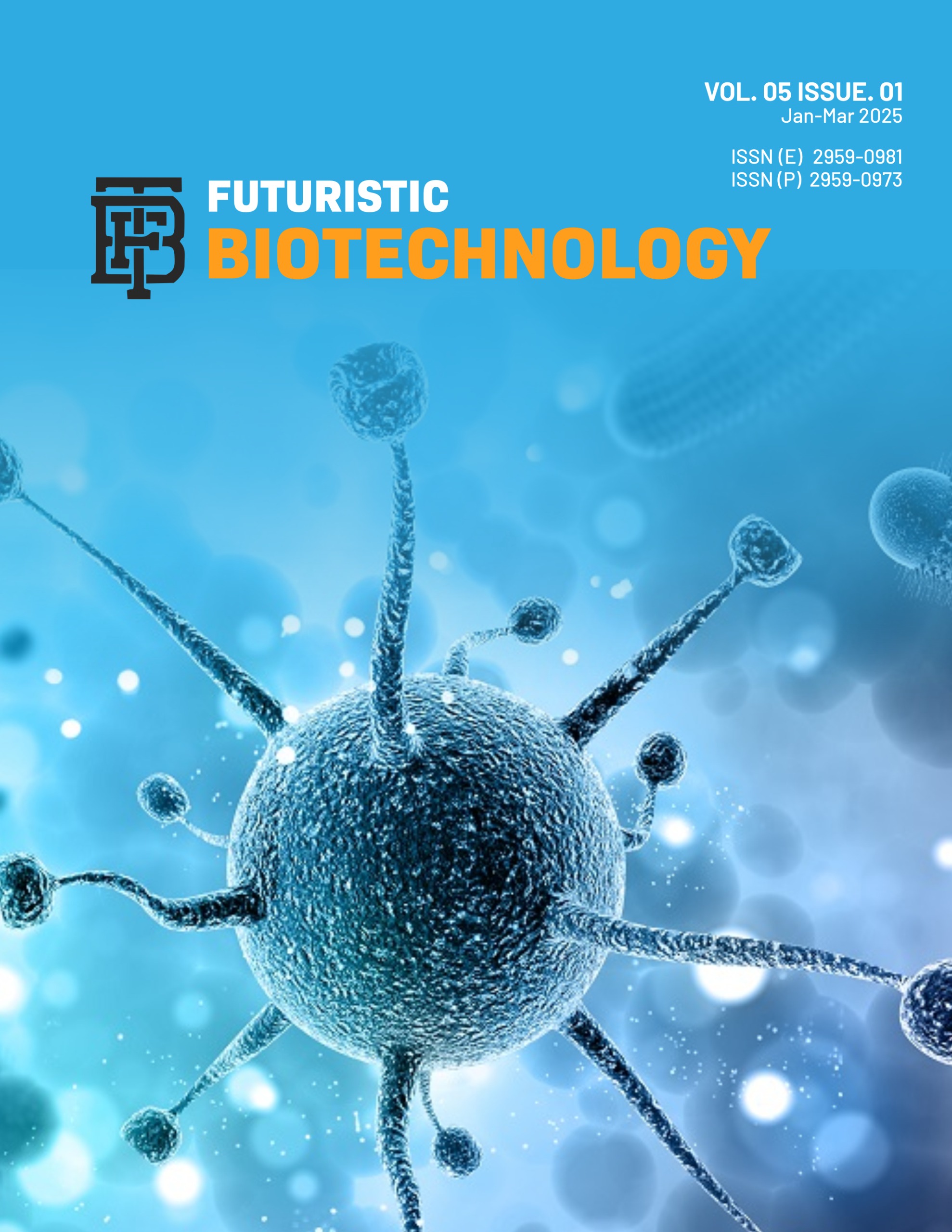Utilization of Size Exclusion Chromatography for the Recovery of Microbial Pectinases
Size Exclusion Chromatography for the Recovery of Microbial Pectinases
DOI:
https://doi.org/10.54393/fbt.v5i1.163Keywords:
DNS Assay, Sephadex G-25 Column, Pectinases, Size Exclusion ChromatographyAbstract
Size exclusion chromatography (SEC) is an effective analytical technique employed for the purification of biomolecules. In size exclusion chromatography (SEC), biomolecules are sorted according to their size. Objectives: To investigate the purification of pectinases from a microbiological source by size exclusion chromatography (SEC). To evaluate the amount of pectinase and total proteins in the collected fractions through measurement and qualitative analysis. Methods: Utilizing Sephadex G-25 as the stationary phase and a 0.05 M sodium phosphate buffer with increasing concentrations of NaCl as the mobile phase. Using a 3,5-dinitro-salicylic acid (DNS) assay and a pectin-containing agar plate assay, the existence of pectinases in the fractions that were taken was verified quantitatively and subjectively. Results: The increasing order of salt concentration was 0.15, 0.5, 0.8, 1 and 1.6 M NaCl concentration. At 0.15 and 0.5 M salt concentrations, desired proteins were strongly combined to the stationary phase of the Sequential Injection Chromatography (SIC) column and eluted at the last fraction while at 0.8, 1 and 1.6 M sodium chloride concentration pectinases were eluted in the early fractions as compared to the buffers containing a lower concentration of sodium chloride. Conclusions: It was concluded that the suitable NaCl concentration for the purification of pectinase enzyme through SEC was 0.8 M because at these concentrations pectinases can be separated very short time and at a low cost.
References
Singh B, Soni SK, Mathur P, Garg N. Microbial Multi-Enzyme Viz., Pectinase, Cellulase and Amylase Production Using Fruit and Vegetable Waste as Substrate a Review. Applied Microbiology. 2024 Aug; 4(3): 1232-46.
Afzia N, Shill N, Kalita BJ, Sit N. Optimization of Conditions for Production of Pectinase in Solid-State Fermentation with Aspergillus Flavus Using Dried Assam Lemon Peel Powder as Substrate. Measurement: Food. 2024 Jun; 14: 100166.
Ahmed NN, Abd El Rahman HM. Optimizing the Production of Pectinase of Orange Peel Waste by Penicillium Chrysogenum MF318506 Using Response Surface Methodology in Submerged Fermentation. Journal of Microbiology, Biotechnology and Food Sciences. 2021 Aug; 11(1): e3931-.
Esawy MA, Gamal AA, Kamel Z. Optimization of Aspergillus Niger NRC1ami Pectinase Using Citrus Peel Pectin, Purification, and Thermodynamic Characterization of the Free and Modified Enzyme. Waste and Biomass Valorization. 2022 Dec; 13(12): 4823-37.
Amin F, Bhatti HN, Bilal M. Recent Advances in the Production Strategies of Microbial Pectinases—A Review. International Journal of Biological Macromolecules. 2019 Feb; 122: 1017-26.
Pang Y, Peng Z, Ding K. An in-depth review: Unraveling the Extraction, Structure, Bio-Functionalities, Target Molecules, and Applications of Pectic Polysaccharides. Carbohydrate Polymers. 2024 Jul: 122457.
Zheng L, Xu Y, Li Q, Zhu B. Pectinolytic Lyases: A Comprehensive Review of Sources, Category, Property, Structure, and Catalytic Mechanism of Pectate Lyases and Pectin Lyases. Bio-Resources and Bioprocessing. 2021 Dec; 8: 1-3.
Haile S and Ayele A. Pectinase from Microorganisms and Its Industrial Applications. The Scientific World Journal. 2022; 2022(1): 1881305.
Pang CY, Wang H, Pang Y, Xu C, Jiao Y, Qin YM et al. Comparative Proteomics Indicates That Biosynthesis of Pectic Precursors Is Important for Cotton Fiber and Arabidopsis Root Hair Elongation. Molecular and Cellular Proteomics. 2010 Sep; 9(9): 2019-33.
Ashaolu TJ, Lee CC, Ashaolu JO, Tarhan O, Pourjafar H, Jafari SM. Pepsin: An Excellent Proteolytic Enzyme for The Production of Bioactive Peptides. Food Reviews International. 2024 Oct; 40(7): 1875-912.
Sujitha P and Shanthi C. Importance of Enzyme Specificity and Stability for the Application of Proteases in Greener Industrial Processing-A Review. Journal of Cleaner Production. 2023 Nov; 425: 138915.
Shrestha S, Rahman MS, Qin W. New Insights in Pectinase Production Development and Industrial Applications. Applied Microbiology and Biotechnology. 2021 Dec; 105: 9069-87.
Yasmin I, Saeed M, Pasha I, Zia MA. Development of Whey Protein Concentrate-Pectin-Alginate Based Delivery System to Improve Survival of B. Longum BL-05 In Simulated Gastrointestinal Conditions. Probiotics and Antimicrobial Proteins. 2019 Jun; 11: 413-26.
Haile S, Masi C, Tafesse M. Isolation and Characterization of Pectinase-Producing Bacteria (Serratia Marcescens) From Avocado Peel Waste for Juice Clarification. Biomed Central Microbiology. 2022 May; 22(1): 145.
Alzahrani OM, Sohail M, Mahmoud SF, Alswat AS, El-Halmouch Y. Preparation of a Pectinase-Enriched Multi-enzyme under Solid State Fermentation of Sugarcane Bagasse. Fermentation. 2023 Jan; 9(2): 141.
Oumer OJ and Abate D. Screening and Molecular Identification of Pectinase-Producing Microbes from Coffee Pulp. BioMed Research International. 2018; 2018(1): 2961767.
KC S, Upadhyaya J, Joshi DR, Lekhak B, Kumar Chaudhary D, Raj Pant B et al. Production, Characterization, and Industrial Application of Pectinase Enzyme Isolated from Fungal Strains. Fermentation. 2020 Jun; 6(2): 59.
De Alencar Guimarães NC, Glienke NN, Galeano RM, Ruller R, Zanoelo FF, Masui DC et al. Polygalacturonase from Aspergillus Japonicus (Pgaj): Enzyme Production Using Low-Cost Carbon Source, Biochemical Properties and Application in Clarification of Fruit Juices. Bio-Catalysis and Agricultural Biotechnology. 2022 Jan; 39: 102233.
Jiang Y, Ye J, Zhou L, Chen M, Wei Y, Jiang S et al. Cell Wall Metabolism During the Growth of Peach Fruit: Association of Hardness with Cell Wall Pectins. Scientia Horticulturae. 2024 Apr; 330: 113058.
Sumiyoshi M, Inamura T, Nakamura A, Aohara T, Ishii T, Satoh S et al. UDP-Arabinopyranose Mutase 3 Is Required for Pollen Wall Morphogenesis in Rice (Oryza Sativa). Plant and Cell Physiology. 2015 Feb; 56(2): 232-41.
Downloads
Published
How to Cite
Issue
Section
License
Copyright (c) 2025 Futuristic Biotechnology

This work is licensed under a Creative Commons Attribution 4.0 International License.
This is an open-access journal and all the published articles / items are distributed under the terms of the Creative Commons Attribution License, which permits unrestricted use, distribution, and reproduction in any medium, provided the original author and source are credited. For comments editor@fbtjournal.com











